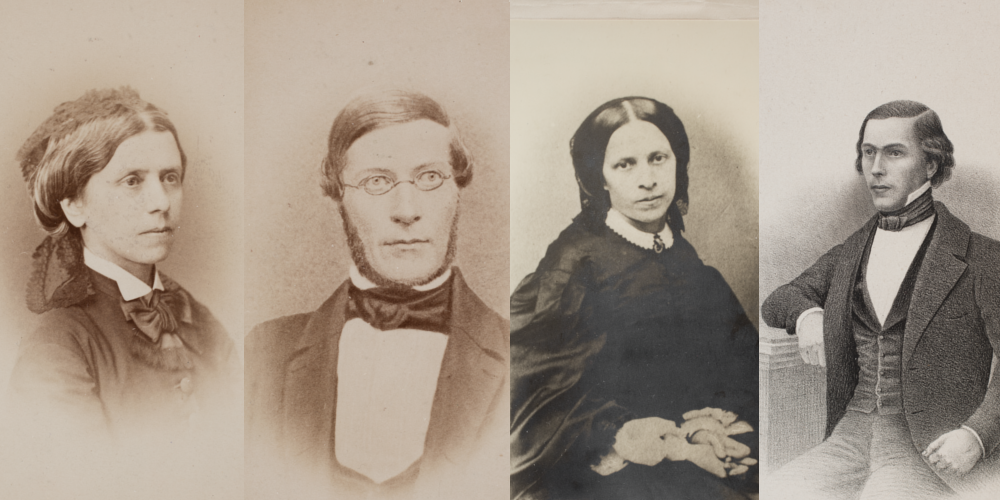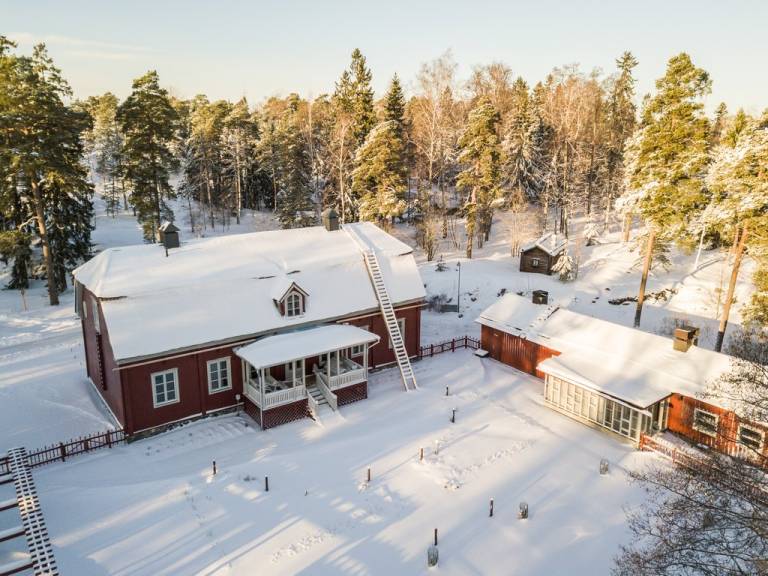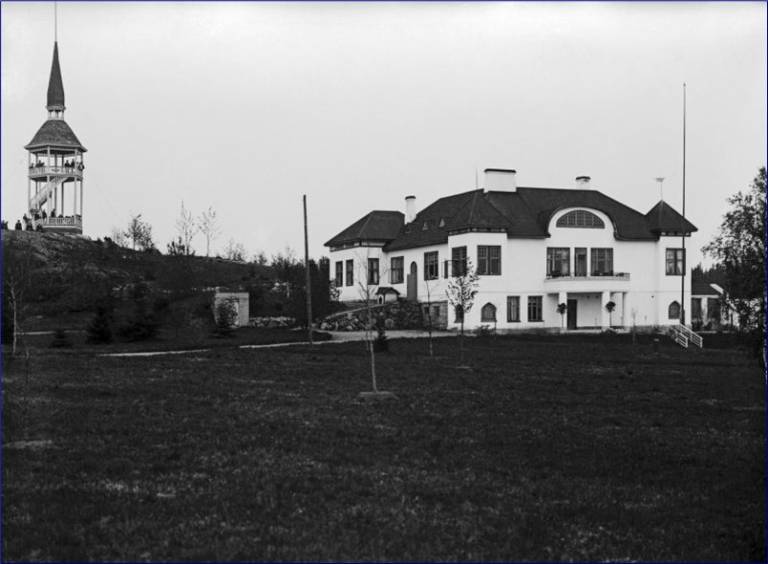The members of the Tengström circle were close to each other as spouses, as friends, as siblings and as colleagues. In which ways have these relationships been important to the nationalistic ideology they shared? How have the close personal relations affected their actions?
I met the Tengström family in the early 2010s while writing my master’s thesis on Jeanette and J. V. Snellman, who were their friends. I was especially drawn to the description of the circle that mingled in Kruununhaka, a district in Helsinki, in the turn of the 1840s and the 1850s. A young man from Helsinki, Robert Lagus, wrote to his brother living in a foreign country and told about the “national assembly” that had formed in Kruununhaka. Many important figures of the 19th century Finland took part – with their wives, as Lagus underlines. Among them were Tengström, Kellgren and Castrén with their wives, Tikkanen with his fiancée and Snellman with his wife. Additionally, many of the women were siblings.
Even more interesting was the fact that, according to Lagus’ poignant description, the role of the women was remarkable in the circle. He wrote to his brother (originally in Swedish):
You might wonder why I so underline the role of the young wives, but that you should not do, because these wives have similar influence and enjoy the same popularity as the men and look even more self-important.
I started researching this group, the heart of which was the family of Tengström. An unbelievable number of famous names and different relationships were tangled together.
The previous generation of Tengströms had already been active in Lauantaiseura, a Finnish nationalistic literary club, in 1830s. This generation was led by the father, professor of philosophy in the Imperial Alexander University, J. J. Tengström. His first spouse and the mother of his children was Sofia Magdalena af Tengström, daughter of an affluential archbishop Jacob Tengström. J. J. and Sofia Magdalena were cousins and therefore the archbishop was not only J. J. Tengström’s father-in-law, but also his uncle. The first wife Sofia Magdalena died young, and after a few years J. J. married his other cousin, Carolina Tengström. Carolina was sister of Fredrika Runeberg, whose spouse, the famous Finnish poet J. L. Runeberg, then became the children’s uncle. Sure enough, J. L. Runeberg was already Tengströms’ second cousin somehow.
The members of the circle of Kruununhaka, who originally piqued my interest, were mainly part of the next generation of Tengstöms. Out of the daughters, Sofi Tengström married linguist and student leader Herman Kellgren, Helene Tengström married journalist Paavo Tikkanen and Natalia Tengström married linguist and explorer M. A. Castrén. What a trio of sons-in-law, I thought. Another member of this generation was the first-born son, who died young, Robert Tengström. He was a friend of the sons-in-law and a promising philosopher.
This abundance of intersecting relationships felt – and still feels – exciting to me. The members of Tengström’s circle were close to each other as spouses, as friends, as siblings and as colleagues. In which ways have these relationships been important to the nationalistic ideology they shared? How have the close personal relations affected their actions?
Women did not live their lives in a separate chapter.
Originally, I was interested especially in the women of the circle. However, I soon realized that the women and the men can’t be separated. “Women did not live their lives in a separate chapter.” I still recall that sentence from a conference on Nordic gender history from a few years ago. In books – anthologies and collections of articles – women may have their own “token chapter”. This way women’s point of view has been noted and checked off. Women – or gender – should not be a stray chapter apart from the “actual” themes, but an integral part of the whole. Therefore, I did not see it purposeful to separate women and men in my research. After all, they did not live apart from each other in real life either.
Additionally, I was interested in the most apparent and visible aspect in the relationship of the Tengströms and the nationalistic ideology: concrete nationalistic action. I realized that social relationships were a lot more than outside, concrete action when we discuss feeling and experiencing subjects. What was more important to them was their own identity and their relationships in relation to the idea of nationalism that they shared.
The word nationalism has a negative tone in everyday language. It is often used to describe hostile, fanatical nationalism. However, in scientific research that is not what the term means, but it refers to building a nation and the phenomena related to nationality and therefore is a neutral term. I use it as such. When it comes to research, the term is in my opinion good and clear, and it is a shame that it cannot be the same in everyday speech and public discourse.
The nature of nationalism as a constructed phenomenon and an ideology is widely recognized in today’s research. We no longer think that nations are objectively and obviously existing, eternal entities, but that they are constructed and formed in historical processes that have progressed through active agents: people. Being a construction does not mean that a nation is somehow unreal. Like many other socially constructed phenomena and communities they are a part of people’s experienced and lived reality.
For the Tengströms and many other people in the 19th century putting forward the Finnish nationalism was a real activity. Their goal was to make the Finns one of the civilized European nations – a special group recognized by others. It was, however, not about xenophobic big talk but they wanted to learn from other nations that were regarded as more advanced.
The mainstream research on nationalism and popular national narrative has focused on men, the public and the political.
The mainstream research on nationalism and popular national narrative has focused on men, the public and the political. Women have been associated with the so-called private, that has been considered as irrelevant when it comes to nationalism. What is more, in these dichotomies, emotions have been associated with the feminine which has categorized them as strangers to the “rational” politics.
In my thesis I wanted to challenge this established setting and prove that both women and men were important agents in nationalistic networks. The difference between the private and the public was not clearly cut, neither was the gender division. Additionally, feelings had – and still have – political and ideological importance – both to women and to men.
I wanted to bring the abstract ideology to the same level with concrete lives. A simple, even naïve question has been bothering me: Why did they start it? Why in the past, someone wanted to dedicate themself to fighting for this cause, to build it, even invent it? I started to look for answers in the personal meaning of the ideology, the “personal nationalism”. This point of view highlights the agency and interpretations of subjects. An ideology must have a personally felt meaning that is affected by a person’s background and features. My study brings up that the personal meaning of an ideology is closely related to building one’s own identity and one’s close relationships and in this process feelings and gender had a central role. The life of one’s own gained a form and a meaning through an ideology, it showed the way. One was able to gain the respect, even love, of their close ones through committing in an ideology. On the other hand, these personal meanings motivated and made possible concrete action. These emotional, even existential, explanations have often been brushed aside, when people have highlighted the inevitability of nationality, the nobility of the ideology or motivations related to superficial profit.
The gender roles that we today see as “conventional” were formed in 19th century educated middle classes, in accord to the nationalistic currents of that time period.
Nationalism and gender are interlinked in many ways. The gender roles that we today see as “conventional” were formed in 19th century educated middle classes, in accord to the nationalistic currents of that time period. The national and the middle-class ideal of men and women were wrapped together. The ideal woman played the role of a mother and an educator of the children, the future citizens. On the other hand, there was the conflict between being an obedient wife and an educated companion to her spouse. However, it is important to note that manhood was built with respect to the nationalism as well, in marriage as well as in the relationships between men. Nationalism gave meaning and nobility to a man’s personal ambitions, for example work related ones, or the main goals of his life. Even though it is clear in today’s research, it is good to be reminded every now and then that man is a gender as well.
Woman and man were seen as opposites that complete each other in the 19th century ideal of polarity. It has often been said that this way they separated the spheres of women and men; the “emotional and passive” for women and the “rational and active” for men. In this schema the natural environment for a woman was home, when men acted in public.
Still, several studies, for example ones dealing with personal history, have pointed out that these spheres were not strictly separate from each other. My own research on the Tengströms supports this diversity and overlap of the spheres. The women had no access to universities, but they read various types of books on their own volition, even literature based on academic lectures. They acted in the field of organizations in the form of philanthropy, which was a part of building their citizenship. The women advanced their male relatives’ careers in different ways. And the men, of course, took part in the life at home: they taught their children and played with them, they relied on their wives and took care of them, bought them coats and medicine.
Naturally, the divide in genders was prevalent in many ways and restrictions were applied to which activities were suitable for women. They even did it themselves. Overall, women took part in restricting their own feminine area of activity in the Finnish field of organizations. Their role in the society was built upon their womanly role as mothers and wives. It is interesting per se, that the political sectors in Finland are still gendered today. Women are social ministers, ministers of health and education, while men are ministers of finance and foreign affairs.
I have wanted to bring up the political meaning of feelings as well. It has gained more and more ground in research as well as in public discussion, but especially the latter often comes with belittling that is often feminized.
The history of emotions has been on the rise, even trendy, in historical studies in the last few years. However, there has been little attention to politics and nationalism, but the intersection of the fields of study is important in my opinion. When it comes to nationalism, we can even say that feelings are in the heart of it, they are an integral part of its ontology. Being a part of a nation has an emotional element. It is often referred to as patriotism.
The history of emotions has been especially interested in norms and conventions, not in personal experiences and relationships. However, abstract phenomena, such as patriotism, can be reached through concrete close relationships. In the Tengström family, the feelings towards loved ones were interlinked and even fused with the love towards Finland and Finnishness. The loved ones and the love toward them and from them were also a motivation and a fuel in concrete, national action.
Contrary to the stereotype of sentimental and hysteric women, it looks like women were required to control their feelings even better than men. Women did – and still do – plenty of emotional labor that harnesses their feelings in service of someone other. It comes from the idea that the mission and the role of woman is to be conformable and nice.
In my research surfaces the historical changeability of emotionality and expression of feelings. The 19th century was a very emotional time period, especially when it comes to the educated classes. The idea that emotionality was not for men does not stand. When it comes to men, emotions were seen as an inner force that lead the way, even a genius. Contrary to the stereotype of sentimental and hysteric women, it looks like women were required to control their feelings even better than men. In a gendered way, this relates to the idea of features typical for women and of power relations, that is whose emotions had a meaning and needed to be taken into consideration. Women did – and still do – plenty of emotional labor that harnesses their feelings in service of someone other. It comes from the idea that the mission and the role of woman is to be conformable and nice.
In the educated classes of the 19th century both women and men wrote emotional letters to their loved ones. Overall, the idea of love was more complex. In addition to lovers, even friends and family members received intense and tender letters. Sometimes this intensive expression of feelings might look strange to us and raise suspicions about the quality of those relationships. Maybe we should ponder if the strange feeling comes from our own, sexually flavored manner of understanding. Especially when it comes to men, the decrease in mutual emotionality has been connected to the fear and scorn of homosexuality. In studies on today’s heterosexual male students it has been pointed out that their friendships have became mentally and physically closer when homophobia has decreased. Maybe the present that is more and more open to different types of love and sexuality begins to open to a more diverse and multifaceted expressions of love in different relationships.
It is often said that we study history to understand the present, maybe even the future. Often becoming absorbed in history challenges the simplified, “traditional” and apparently obvious views – in my research they are related to nationalism, emotions and gender. These people of the 19th century fascinate me because of the ideological and emotional strength and intensity conveyed through their expressions and their lives. I wonder if their experiences and their ways of understanding were truly and even wildly different from those of the people living in the 21st century. I think that might be the case.
This text by Reetta Eiranen was first published by Ennen ja nyt in Finnish. Her thesis can be found here (in Finnish).
Translation by Tiia Tikka. The translator is a Master’s-level student of Multilingual Communication and Translation Studies at Tampere University. The translation was produced as part of a project course in English Translation.






